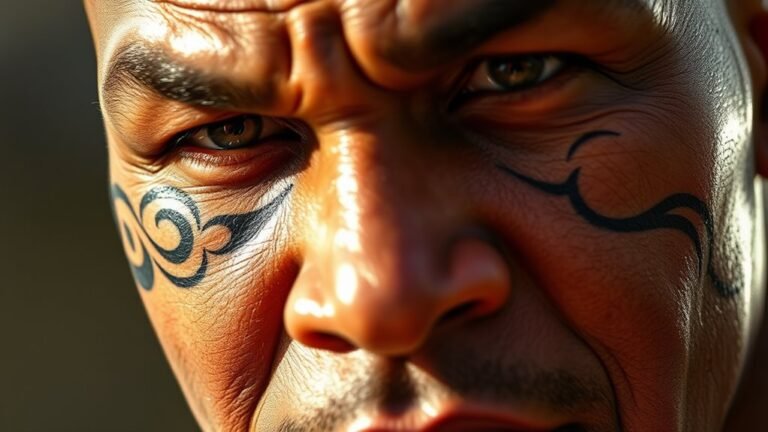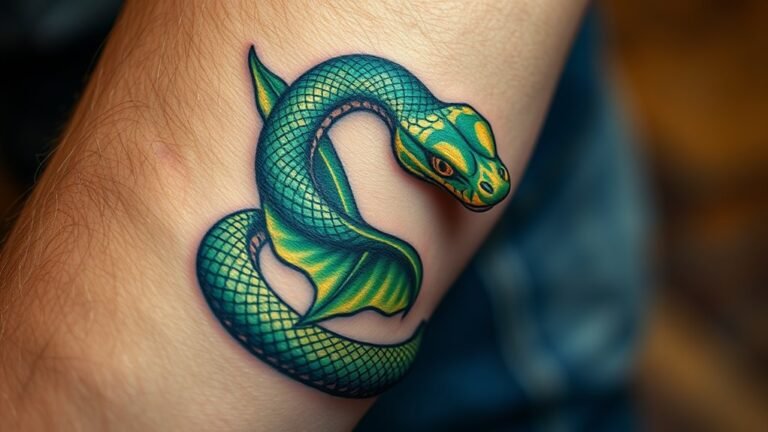Native Indian Tattoo Meaning and Symbolism
When you explore Native Indian tattoos, you'll find that each design isn't just an aesthetic choice but a profound expression of identity and culture. These tattoos often signify personal journeys, tribal affiliations, and spiritual beliefs, connecting individuals to their history and community. You might be surprised by the rich symbolism behind common motifs like the dreamcatcher or the eagle, each representing values such as protection and wisdom. But why do these meanings matter in today's context? Understanding this can reveal much about the ongoing relationship between tradition and modernity.
Historical Context of Tattoos
While many cultures have embraced tattoos as a form of self-expression, the historical context of Native Indian tattoos reveals a rich tapestry of tradition and meaning.
For Indigenous peoples, tattoos aren't just body art; they're deeply intertwined with cultural significance and identity. Each mark tells a story, often representing personal milestones, tribal affiliation, or spiritual beliefs.
You'll find that tattoo history among Native Indians reflects a connection to ancestry and the natural world, providing a sense of belonging in an ever-changing society.
As you explore this legacy, you'll uncover how these symbols foster community ties and resilience, reminding you that every tattoo carries a piece of history, echoing the voices of generations past.
Common Symbols and Their Meanings
As you delve into the world of Native Indian tattoos, you'll discover that each symbol carries profound significance, often rooted in the beliefs and values of the tribe.
Common symbols like the dreamcatcher represent protection and the filtering of dreams, embodying hope and resilience. The medicine wheel symbolizes holistic health and the interconnectedness of life, showcasing the cultural significance of balance.
Each tattoo serves as an artistic expression of identity, carrying stories that connect you to your heritage. The arrow indicates direction and strength, while the thunderbird symbolizes power and transformation.
Understanding these symbols deepens your appreciation for their meanings, fostering a sense of belonging to a rich cultural tapestry that celebrates both individual and collective histories.
Animal Representations in Tattoos
Animal representations in Native Indian tattoos hold deep significance, often embodying the traits and spiritual connections associated with each creature.
For instance, wolf symbolism reflects loyalty and teamwork, while eagle representation signifies freedom and a higher perspective. The bear meanings often connect to strength and courage, making it a popular choice for those seeking empowerment.
Turtle significance emphasizes wisdom and longevity, appealing to those who value patience. Coyote traits represent adaptability and cunning, perfect for individuals navigating challenges.
Deer symbolism embodies gentleness and grace, resonating with those who appreciate harmony. Serpent representations signify transformation and healing, while owl meanings connect to wisdom and intuition, guiding you in your journey of self-discovery through these powerful animal motifs.
Spiritual Significance of Tattoos
Tattoos in Native Indian culture often serve as powerful spiritual symbols, reflecting a deep connection to the earth and the universe. Each tattoo tells a story, marking milestones in your spiritual journeys.
Through tattoo rituals, you can embody the essence of your experiences, creating a visual representation of personal growth and transformation. These rituals often involve communal participation, enhancing your sense of belonging within the tribe.
The designs, infused with meaning, act as a bridge between the physical and spiritual realms, guiding you toward inner wisdom. By embracing these tattoos, you're not just adorning your body; you're honoring your heritage and deepening your spiritual path, fostering a sense of unity with both your ancestors and the natural world around you.
Tribal Variations in Designs
While each Native Indian tribe has its own unique cultural influences, the variations in tattoo designs often reflect distinct beliefs, stories, and traditions.
You'll find that tribal symbolism plays a crucial role in these designs, with each element carrying significant meaning. For instance, the intricate lines of a Lakota tattoo might represent the connection to the earth and sky, while a Navajo design could symbolize harmony and balance.
These design variations showcase the rich tapestry of Native cultures, inviting you to explore deeper connections to heritage and identity.
Gender Differences in Tattoo Meanings
Exploring the rich tapestry of tribal tattoo designs naturally leads to a discussion on how gender influences their meanings. In Native Indian cultures, masculine symbolism often embodies strength, bravery, and protection. Common designs for men might include images of animals or warriors, signifying power and dominance.
Conversely, feminine expression typically embraces themes of nurturing, beauty, and community. Women might choose designs that reflect nature or ancestral ties, celebrating life and harmony.
These gendered interpretations foster a sense of belonging within the community, allowing individuals to connect with their heritage. Ultimately, understanding these differences enriches your appreciation for the depth and significance of tribal tattoos, highlighting how they serve as personal and communal identifiers that resonate across generations.
Tattooing Techniques and Materials
When considering the artistry behind Native Indian tattoos, it's essential to delve into the techniques and materials that shape these intricate designs.
You'll find that traditional tools like sharpened sticks, bone needles, and even fishhooks play a crucial role in the process. The ink application techniques vary, often involving hand-tapping or pricking the skin to ensure the ink penetrates deeply, creating vibrant, lasting imagery.
These methods reflect a connection to ancestral practices, emphasizing not just beauty but also cultural significance. Every stroke tells a story, linking you to a rich heritage.
The Role of Nature in Tattoos
Nature plays a pivotal role in the symbolism and inspiration behind Native Indian tattoos, as these designs often reflect the deep connection tribes have with their environment. Each tattoo tells a story, embodying the essence of nature and its profound significance in daily life.
- Animals represent strength and guidance.
- Plants signify growth and healing.
- Elements like water and fire embody transformation.
- Celestial symbols connect to the spiritual realm.
Through nature symbolism, these tattoos serve as a reminder of the balance and harmony within the ecosystem.
You'll find that environmental inspiration not only enriches the designs but also fosters a sense of belonging, reminding you of your roots and the intricate web of life that surrounds us all.
Personal Narratives Through Tattoos
Tattoos serve as powerful personal narratives, capturing individual stories and experiences in a way that transcends spoken language. Each design embodies your personal stories, reflecting milestones, struggles, or heritage.
They're more than ink; they're cultural expression, connecting you to your roots and community. When you wear a tattoo, you invite others to witness your journey, fostering a sense of belonging.
Each symbol carries significance, often rooted in tradition, making your experience relatable to those who share similar backgrounds or emotions. Through these markings, you find a voice, articulating feelings and memories that words may fail to express.
In this way, tattoos become a canvas of your life, celebrating both your individuality and your connection to a larger narrative.
Modern Adaptations of Traditional Designs
As you explore the world of body art, you'll notice how modern adaptations of traditional Native Indian designs have evolved, blending rich cultural heritage with contemporary aesthetics.
This cultural fusion creates a unique expression, allowing individuals to connect with their roots while embracing current trends. These adaptations often reflect personal stories, making them deeply meaningful.
- Incorporation of geometric patterns
- Use of vibrant colors and abstract forms
- Fusion with other cultural motifs
- Custom designs that honor traditional symbolism
The Impact of Colonialism on Tattoo Art
Modern adaptations of traditional designs showcase a vibrant tapestry of cultural expression, yet the influence of colonialism casts a long shadow over the evolution of Native Indian tattoo art.
As you explore these tattoos, you'll notice how historical erasure effects have stripped many designs of their original meanings, leaving a fragmented connection to ancestral roots.
Cultural appropriation issues further complicate this landscape, as non-Indigenous artists often adopt these symbols without understanding their significance, diluting their power.
This disconnection fosters a longing for authenticity and belonging among Indigenous communities, who strive to reclaim their narratives.
Ultimately, recognizing the impact of colonialism on tattoo art invites a deeper appreciation for its true significance and fosters a more respectful engagement with Indigenous cultures.
Preserving Indigenous Tattoo Traditions
While acknowledging the historical challenges faced by Indigenous cultures, many communities are actively working to preserve their tattoo traditions as vital expressions of identity and heritage.
You can participate in this cultural preservation through various engaging avenues:
- Attend tattoo workshops led by Indigenous artists.
- Learn the meanings and stories behind specific designs.
- Support local artisans who embody these traditions.
- Share your experiences and newfound knowledge within your community.
Frequently Asked Questions
How Do Native Indian Tattoos Differ From Modern Tattoo Styles?
Native Indian tattoos often showcase intricate tribal patterns deeply rooted in cultural influences, reflecting heritage and identity. In contrast, modern styles can prioritize personal expression, sometimes lacking the historical significance and communal connection found in traditional designs.
Are There Specific Rituals Associated With Getting a Native Indian Tattoo?
When you explore tattoo ceremonies, you'll find they often carry deep cultural significance. Participating in these rituals not only connects you to traditions but also fosters a sense of belonging within the community and its history.
Can Anyone Get a Native Indian Tattoo, Regardless of Heritage?
Yes, anyone can get a tattoo, but consider cultural appropriation. It's essential to understand the significance behind it and reflect on your personal identity. Respecting the culture enriches your experience and fosters meaningful connections.
What Is the Significance of Colors Used in Native Indian Tattoos?
When you explore color symbolism in tattoos, you'll discover rich cultural meanings. Each hue conveys emotions and stories, connecting you to a deeper heritage. Understanding these colors can enhance your appreciation for the art form.
How Can One Respectfully Choose a Native Indian Tattoo Design?
When choosing a tattoo design, ensure you embrace cultural appreciation. Research the symbolism, consult with community members, and aim for respectful representation. It's vital to honor traditions to connect deeply and meaningfully with your choice.












